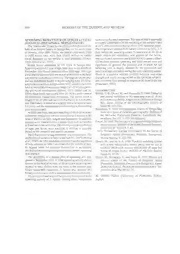
Spawning behaviour of Sergia lucens (Hansen) (Decapoda: Sergestidae) PDF
Preview Spawning behaviour of Sergia lucens (Hansen) (Decapoda: Sergestidae)
396 MEMOIRS OF THE QUEENSLAND MUSEUM SPAWNING BEHAVIOUR OF SERGIA LUCENS seems to be the most important. The start of heavy spawning (HANSEN) (DECAPODA: SERGESTIDAE) is roughly associated with the warming of the surface water The 8Sakura-ebi9 Sergia lucens (Hansen) has provided the {o 24°C and vertical oscillation of the 18°C-isotherm depth. base of an historic fishery in Suruga Bay, on the south coast The temperature around 40 m rapidly increases to 18°C, 3-7 of Honshu, since 1894. Today, the annual catch totals 2500 days before the spawning peaks. Temperature at 20-50 m to 3000 metric tons, more than US$20 million in landed depth affects the abundance and growth of the larvae, value. Research on the shrimp is well advanced (Omori. whereas food is abundant and would not have great a effect. 1969; Omori et al., 1973). Correlations between spawning and Junar period were not Sergia lucens completes its life cycle in Suruga Bay. significant. In general, the potential size of stock for the Spawning occurs al J year of age, from June to the middle of following year is largely affected by the production and November. One female produces about 2000 eggs. The eggs survival of eggs and larvae during the early spawning season. are primarily spawned near the mouth of the riversal the head There is a positive rélation (r<0.01) between year-class part and the western part of the bay. The eggs are planktonic. strength and yearly average width of the optimum tempera- and are distributed mostly at depths ranging from 20-50 m, ture Zone from June through to August al the head of the bay where the temperature is higher than 18°C, which js the lower (Nakamura, 1982), limit of the optimal iemperature range (18°425°C) for spawn- ing and larval development (Omori, 1971; Omori and Jo. Literature Cited 1989), Eggs hatch into nauplii afler 24~36 hrs under normal Bishop. G.H., Omori, M., and Muranaka, F, 1989. Temporal environmental temperature conditions. The larvae attain a and spatial variations in the spawning activity of the length of 20-25 mm and recruit ta the fishery at 3-4 months micronektonic shrimp, Sergia fucens (Hansen) in Suruga old. The fishery is based on a species with a lifespan of only Bay, Japan. Journal of the Oceanographic Society of 1,5 years, and the tecruitment is instrumental in determining Japan 45: 243-250. year-class strength. Nakamura, V, 1982. Oceanographic feature of Suruga Bay Tn 1985 and 1986, frequent sampling of the 0-50 m water from view point.of fisheries oceanography. Bulletin of column by vertical tow net was conducted al 2 stanons at the the Shizuoka Prefectural Fisheries Experiment Sta- head of the bay torJuly, August and Seplember. In addilion, tion(Spec. No.) 17: 1-153. [In Japanese). samples were obtained once a month from Juné to October Omori, M, 1969, The biology of as ergeslid shrimp Sergesles at 8 stations in the entire bay. The abundance and distribution lucens Hansen, Bulletin of the Ocean Research Institute, of eggs and larvae were analysed in relation to possible University of Tokyo 4: 1-83. causes of the temporal and spatial yariations, 1971. Preliminary rearing experiments on the laryae of Daily fluctuation in egg abundance was considerable. The Sergestes lucens (Penaeidea, Nalantia, Decapoda), coefficient of variation in July varied from 814269°% (Bishop Marine Biology 9: 228-234. etal., 1989), In 1985 spawning occurred from the beginning Omori, M., and Jo, 5.-f. 1989. Plankton sampling system of July, whereas in 1986 it occurred after the middle of July. wilh a new submersible voriex pump and its use to In August when the seasonal thermocline js particularly estimate small-scale vertical distribution of eggs and marked and the optimum temperature zone narrow, spawning, larvae of Sergia lucens. Bulletin of Plankton Society was reduced, Japan 36: 19-26, The possibility of a second peak of spawning was sug- Omori, M., Konagaya, T., and Noya, K. 1973. History and gested in September 1985. In 1986 spawning activity did nat present status of the fishery of Sergestes lucens recover al the head of the bay, as the principal spawning area (Penaeldea, Decapoda, Crustacea) in Suruga Bay, Japan. seemed to have shifted from the head to the western part. Journal du Conseil, Permanent Intemational pour9 Ex- Under favourable conditions, 5, lucens may produce two ploration de la Mer 35; 61-77. broods in one season with a considerable interval between. Many external and internal factors may be involved in the M, Omori, Tokyo University of Fisheries, Tokyo, spawning activity of §, /ucens. Among (hem, temperature Japan,
